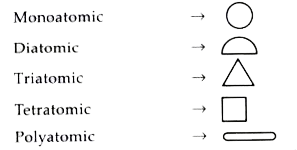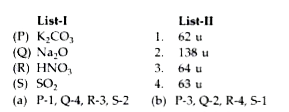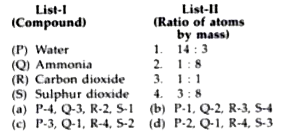EXERCISE (INTEGER/NUMERICAL VALUE TYPE) from MTG IIT JEE FOUNDATION ATOMS AND MOLECULES for Class 9
| Class 9 | CHEMISTRY |
| Chapter | ATOMS AND MOLECULES |
| MTG IIT JEE FOUNDATION | EXERCISE (INTEGER/NUMERICAL VALUE TYPE) |
| Medium | English |
| Academic Year | 2023-2024 |
Question 48
In an experiment, 1.50 g of pure copper(II) oxide was reduced to pure metal by heating with pure carbon. In another experiment, 1.15 g of pure copper was treated with nitric acid and the product formed was heated strongly till no further change was observed. The mass of copper(II) oxide so formed was found to be 1.40 g. The mass of pure metal formed in the first experiment and the law followed are respectivelyView SolutionQuestion 50
The given figure shows the set-up to study the reaction between gas X and copper (II) oxide :

Which of the following statements are correct? (Given : Atomic mass of N = 14 u, H = 1 u, O = 16 u, C = 12u)
I. Gas X is a compound of two elements, nitrogen and hydrogen.
II. The number of atoms present in 11.2 L of N2 is 6.023×1023
III. 1 mole of H2O contains 1 mole of oxygen molecules and 2 moles of hydrogen atoms.
IV. N2 gas being soluble in water is collected by upward displacement of water.View SolutionQuestion 66
PASSAGE-I :A mole of an atom is a collection of atoms whose total mass is the number of grams equal to the atomic mass. Since equal number of moles of different elements contain an equal number of atoms it becomes convenient to express the amounts of the elements in terms of moles. A mole represents a definite number of particles viz, atoms, molecules, ions or electrons. This definite number is called Avogadro number or Avogadro constant which is equal to 6.022×1023 Hence a mole represents 6.022×1023 particles of the substance. One mole of substance represents one gram-formula of the substance. One mole of a gas at standard temperature and pressure occupies 22.4 litres.
How many grams of sodium must be taken to get 1 mole of the element ?View SolutionQuestion 67
PASSAGE-I :A mole of an atom is a collection of atoms whose total mass is the number of grams equal to the atomic mass. Since equal number of moles of different elements contain an equal number of atoms it becomes convenient to express the amounts of the elements in terms of moles. A mole represents a definite number of particles viz, atoms, molecules, ions or electrons. This definite number is called Avogadro number or Avogadro constant which is equal to 6.022×1023 Hence a mole represents 6.022×1023 particles of the substance. One mole of substance represents one gram-formula of the substance. One mole of a gas at standard temperature and pressure occupies 22.4 litres.
What is the mass in grams of a single atom of chlorine? (Atomic mass of chlorine = 35.5)View SolutionQuestion 68
PASSAGE-I :A mole of an atom is a collection of atoms whose total mass is the number of grams equal to the atomic mass. Since equal number of moles of different elements contain an equal number of atoms it becomes convenient to express the amounts of the elements in terms of moles. A mole represents a definite number of particles viz, atoms, molecules, ions or electrons. This definite number is called Avogadro number or Avogadro constant which is equal to 6.022×1023 Hence a mole represents 6.022×1023 particles of the substance. One mole of substance represents one gram-formula of the substance. One mole of a gas at standard temperature and pressure occupies 22.4 litres.
How many number of moles are there in 5.75 g of sodium ? (Atomic mass of sodium = 23) View SolutionQuestion 69
PASSAGE-I :A mole of an atom is a collection of atoms whose total mass is the number of grams equal to the atomic mass. Since equal number of moles of different elements contain an equal number of atoms it becomes convenient to express the amounts of the elements in terms of moles. A mole represents a definite number of particles viz, atoms, molecules, ions or electrons. This definite number is called Avogadro number or Avogadro constant which is equal to 6.022×1023 Hence a mole represents 6.022×1023 particles of the substance. One mole of substance represents one gram-formula of the substance. One mole of a gas at standard temperature and pressure occupies 22.4 litres.
What is the mass in grams of 2.42 mol of zinc? (Atomic mass of Zn = 65.41)View SolutionQuestion 70
PASSAGE-II : The percentage composition of elements in a compound is calculated from the molecular formula of the compound. The molecular mass of a compound is calculated from the atomic masses of the various elements present in the compound. The percentage of mass of each element is then calculated by the help of the following relation. Percentage mass of the element in the compound =Mass of the elementMass of the compound×100
What is the percentage of calcium in calcium carbonate?View SolutionQuestion 71
PASSAGE-II : The percentage composition of elements in a compound is calculated from the molecular formula of the compound. The molecular mass of a compound is calculated from the atomic masses of the various elements present in the compound. The percentage of mass of each element is then calculated by the help of the following relation. Percentage mass of the element in the compound =Mass of the elementMass of the compound×100
View SolutionQuestion 72
PASSAGE-II : The percentage composition of elements in a compound is calculated from the molecular formula of the compound. The molecular mass of a compound is calculated from the atomic masses of the various elements present in the compound. The percentage of mass of each element is then calculated by the help of the following relation. Percentage mass of the element in the compound =Mass of the elementMass of the compound×100
View SolutionQuestion 73
PA SSAGE-III: According to Dalton's atomic theory, all matter whether an element, a compound or a mixture is composed of small particles called atoms which can neither be created nor destroyed during a chemical reaction. Dalton's theory provides a simple explanation for the laws of chemical combination. He used his theory to explain law of conservation of masses, law of constant proportions and law of multiple proportions, based on various postulates of the theory. Dalton was the first scientist to use the symbols for the elements in a very specific sense. When he used a symbol for an element he also meant a definite quantity of that element, that is one atom of that element.
Which postulate of Dalton's atomic theory is the result of the law of conservation of mass?View SolutionQuestion 74
PA SSAGE-III: According to Dalton's atomic theory, all matter whether an element, a compound or a mixture is composed of small particles called atoms which can neither be created nor destroyed during a chemical reaction. Dalton's theory provides a simple explanation for the laws of chemical combination. He used his theory to explain law of conservation of masses, law of constant proportions and law of multiple proportions, based on various postulates of the theory. Dalton was the first scientist to use the symbols for the elements in a very specific sense. When he used a symbol for an element he also meant a definite quantity of that element, that is one atom of that element.
Which postulate of Dalton's atomic theory explains law of definite proportions?View SolutionQuestion 75
PA SSAGE-III: According to Dalton's atomic theory, all matter whether an element, a compound or a mixture is composed of small particles called atoms which can neither be created nor destroyed during a chemical reaction. Dalton's theory provides a simple explanation for the laws of chemical combination. He used his theory to explain law of conservation of masses, law of constant proportions and law of multiple proportions, based on various postulates of the theory. Dalton was the first scientist to use the symbols for the elements in a very specific sense. When he used a symbol for an element he also meant a definite quantity of that element, that is one atom of that element.
"If 100 g of calcium carbonate (whether in the form of marble or chalk) are decomposed, 56 g of calcium oxide and 44 g of carbon dioxide are formed." Which law of chemical combination is illustrated by this statement?View SolutionQuestion 76
PA SSAGE-III: According to Dalton's atomic theory, all matter whether an element, a compound or a mixture is composed of small particles called atoms which can neither be created nor destroyed during a chemical reaction. Dalton's theory provides a simple explanation for the laws of chemical combination. He used his theory to explain law of conservation of masses, law of constant proportions and law of multiple proportions, based on various postulates of the theory. Dalton was the first scientist to use the symbols for the elements in a very specific sense. When he used a symbol for an element he also meant a definite quantity of that element, that is one atom of that element.
When 5 g calcium is burnt in 2 g oxygen, 7 g of calcium oxide is produced. When 5 g of calcium is burnt in 20 g of oxygen, then also 7 g of calcium oxide is produced. Which law of chemical combination is being followed?View SolutionQuestion 77
PA S S A G E -I V : The molecular mass of a substance is the relative mass of its molecule as compared with the mass of a carbon-12 atom taken as 12 units. The molecular mass of a substance indicates the number of times one molecule of a substance is heavier than 112 of C-12 atom. It is equal to the sum of atomic masses of all the atoms present in a molecule. Depending on the number of atoms of same or different elements present in the molecule, it can be monoatomic, diatomic, triatomic, tetratomic or a polyatomic molecule.
Which is an example of a polyatomic molecule?View SolutionQuestion 78
PA S S A G E -I V : The molecular mass of a substance is the relative mass of its molecule as compared with the mass of a carbon-12 atom taken as 12 units. The molecular mass of a substance indicates the number of times one molecule of a substance is heavier than 112 of C-12 atom. It is equal to the sum of atomic masses of all the atoms present in a molecule. Depending on the number of atoms of same or different elements present in the molecule, it can be monoatomic, diatomic, triatomic, tetratomic or a polyatomic molecule.
Total number of atoms in 44 g of CO2 is :View SolutionQuestion 79
PA S S A G E -I V : The molecular mass of a substance is the relative mass of its molecule as compared with the mass of a carbon-12 atom taken as 12 units. The molecular mass of a substance indicates the number of times one molecule of a substance is heavier than 112 of C-12 atom. It is equal to the sum of atomic masses of all the atoms present in a molecule. Depending on the number of atoms of same or different elements present in the molecule, it can be monoatomic, diatomic, triatomic, tetratomic or a polyatomic molecule.
Carbon dioxide, hydrogen sulphide, calcium chloride and sodium oxide are examples ofView Solution
All Exercises from MTG IIT JEE FOUNDATION Class 9 CHEMISTRY ATOMS AND MOLECULES
- NCERT SECTION
- EXERCISE (ASSERTION & REASON TYPE)
- EXERCISE (COMPREHENSION TYPE)
- EXERCISE (INTEGER/NUMERICAL VALUE TYPE)
- EXERCISE (MATCH THE FOLLOWING)
- EXERCISE (MULTIPLE CHOICE QUESTIONS LEVEL-1)
- EXERCISE (SUBJECTIVE PROBLEMS LONG ANSWER TYPE)
- EXERCISE (SUBJECTIVE PROBLEMS SHORT ANSWER TYPE)
- EXERCISE (SUBJECTIVE PROBLEMS VERY SHORT ANSWER TYPE)
- OLYMPIAD/HOTS CORNER
- ILLUSTRATIONS
- SOLVED EXAMPLES







